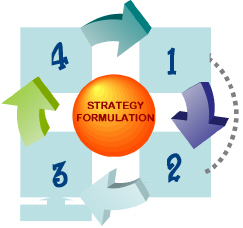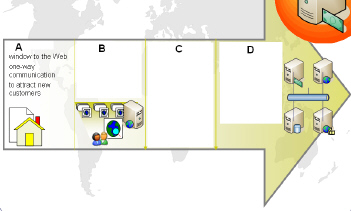Multiple Choice
Identify the
choice that best completes the statement or answers the question.
|
|
|
1.
|
Select the primary technology for the digital firm
a. | Internet | c. | Extranet | b. | Intranet | d. | XML |
|
|
|
2.
|
Despite the benefits, there are several limitations associated with the
application of Internet technology in business - select the item least recognised as such a
limitation
a. | Customers cannot physically examine products | b. |
Extra logistical
costs are required to assemble, pack, and move small shipments |
c. |
Learning about
suppliers and customers is limited by the lack of face-to-face contact |
d. |
Delays, due to
shipment, in providing the goods or services to the end customer |
e. | Customers receive
less information about the goods they are purchasing |
|
|
|
3.
|
Richness is defined by three aspects of information itself - select the
item which is not one of those aspects
a. |
The amount of information |
b. |
Quality |
c. |
The degree to which
the information can be customized |
d. |
Interactivity |
|
|
|
4.
|
The process of doing away with ‘middlemen’ from business
transactions is termed
a. |
Reintermediation |
c. |
Intermediation |
b. |
Virtual markets |
d. | Disintermediation |
|
|
|
5.
|
 With reference to the e-strategy formulation process -
select the item that correctly corresponds to stage 2 in the diagram a. | Aims | c. | Options | b. | Plan | d. | Analysis |
|
|
|
6.
|
 With reference to the e-strategy formulation process -
select the item that correctly corresponds to stage 3 in the diagram a. | Aims | c. | Options | b. | Plan | d. | Analysis |
|
|
|
7.
|
Select the most correct definition for the term Channel
cannibalisation
a. |
The increase in sales through an existing channel due to the introduction of a new
channel |
b. | A situation whereby an existing channel ceases to be profitable due to the
introduction of a new channel | c. |
The decrease in sales through an existing
channel due to the introduction of a new channel |
d. | A situation whereby an existing channel
becomes profitable due to the introduction of a new channel |
|
|
|
8.
|
Rao, Metts and Monge (2003) propose e-commerce development takes place in four
stages, which item refers to a stage not identified by Rao, Metts and Monge (2003)?
a. |
Presence |
d. |
Transactions integration |
b. |
Portals |
e. |
Enterprises integration (EI) |
c. | Systems
integration |
|
|
|
9.
|
The CAGE framework of distance presented by Ghemawat (2001) considers four
attributes - which is not one of those attributes?
a. |
Cultural distance |
c. |
Geographic distance |
b. |
Administrative (or political) distance
|
d. |
Environmental distance
|
|
|
|
10.
|
Consider the e-commerce stage model  Which stage is
identified with the letter “B”? a. | Enterprise integration | c. | Transaction Integration | b. | Presence | d. | Portals |
|
|
|
11.
|
Consider the e-commerce stage model  Which stage is
identified with the letter “D”? a. | Enterprise integration | c. | Transaction Integration | b. | Presence | d. | Portals |
|
|
|
12.
|
Consider the e-commerce stage model - Which stage is described
below?
This stage is viewed as the introduction of two-way communication, customer or supplier
order placing, the use of profiles and cookies. The information provided in the presence stage can be
coupled with facilities for ordering, product feedback, and product and/or quality surveys.
a. | Enterprise integration | c. | Transaction Integration | b. | Presence | d. | Portals |
|
|
|
13.
|
The ideas to exploit Net technology opportunities are encapsulated within
business models. Select the least true statement about such models
a. | A Revenue model is the specific modes in which a business model enables revenue
generation (subscription fees, advertising fees, and transactional income) | b. | Much of the value
created by e-business is due to the more effective use of information. | c. | In the
direct-to-customer model, buyer and seller communicate through intermediaries creating the potential
for the provider to develop a primary relationship with customers. | d. | There are many ways
for the international organization to earn revenue through EC | e. | The Business model
describes the organization's essential logic for consistently achieving its principle
objectives- explains how it consistently makes money, highlights the distinctive activities and
approaches that enable the firm to succeed—to attract customers and deliver products and
services profitably |
|
|
|
14.
|
Gulati and Garino (2000) investigate how incumbent companies move onto the
Web.Identify the incorrect item/ alternative.
a. |
Clicks-and-mortar strategies with a separate Internet businesses |
b. |
Simply remaining as
a bricks-and-mortar, traditional (physical) organization - the Seamless Strategy
|
c. |
Clicks-and-mortar strategies, tightly integrating Web site and physical stores
– |
d. |
Partnering with another company |
|
|
|
15.
|
Compare and contrast traditional with net technology information delivery
mechanisms. Select the least true statement
a. | Traditional information delivery mechanisms include TV, Radio and
Paper | b. | Traditional information delivery mechanisms enable relationship building, and deliver
rich information | c. | Traditional information delivery mechanisms use monologue | d. |
Net technology
information delivery mechanisms support dialogue |
|